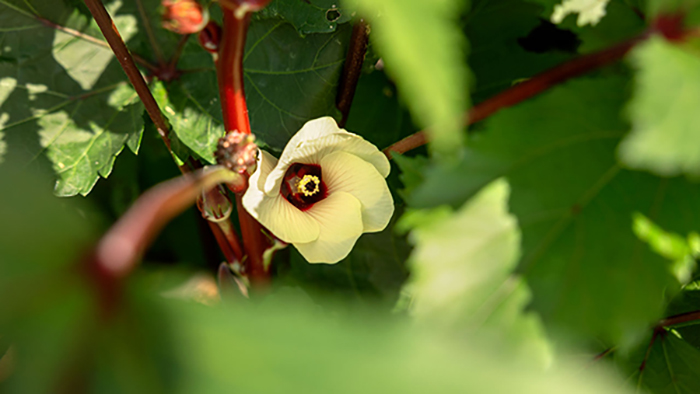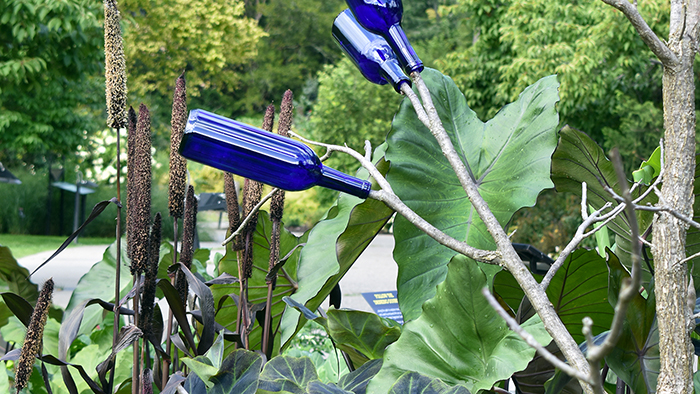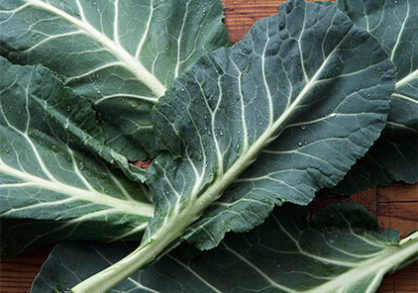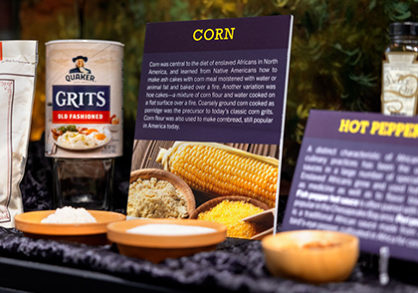Last year, Cornell Botanic Gardens launched “Seeds of Survival and Celebration: Plants and the Black Experience,” a garden installation and exhibit that honors the plants and plant knowledge significant to African American culture dating to the transatlantic slave trade. In summer and fall 2023, the exhibition returns with an expanded plant collection, more stories, and vernacular garden features reflective of African American culture.
Seeds of Survival and Celebration bears witness to the survival of a people despite tragic histories while celebrating the lasting influence of the formerly enslaved and their descendants on American culture.
“This is a story that has been in existence, but not very well known or told,” said Catherine Thrasher-Carroll, a member of the advisory group for the project and former mental health promotion program director at Cornell Health. “I am very proud to be a Black person. I have ancestors who were enslaved people in Griffin, Georgia. These stories represent their ability to survive, and their creativity in the use of the earth and plants.”
Through a living display of plants, the exhibit tells four stories:
- African food plants grown to supplement enslaved peoples’ insufficient food rations
- Plants grown for medicinal remedies
- How non-African plants were integrated into traditional African dishes
- Cash crops enslaved Africans were forced to cultivate and harvest, such as sugar cane, cotton, and tobacco

This year’s garden features more than 43 species of plants of more than 79 distinct varieties, illustrating the breadth and diversity of African Americans’ plant knowledge.
“Descriptions of how these plants were used humanize the enslaved person’s experience and demonstrate the traditions from West Africa that are retained today,” said Sarah Fiorello, interpretation coordinator for Cornell Botanic Gardens.
“Africans were ripped away from their homes, families, communities, and culture, and forced into a life of hardship and poverty,” she said. “It’s exceptional how much of their cultural traditions were preserved and the resilience it took to do that.”
The plants in the installation often serve as powerful reminders of family histories and ancestral connections. For Thrasher-Corroll, this is sorghum, which her father grew on the small Ohio farm where he was raised. For Jakara Zellner ‘23, one of the collaborators of the exhibit, cotton is the plant that touches her.
“Cotton was a main cash crop, but it was also used by pregnant enslaved women to help induce labor,” Zellner said. “Cotton is the plant that was most harmful to these people and yet, they turned it into something that was useful for them. This encompasses how enslaved people were fighting for their freedom and to survive in those moments.”
The plants used by enslaved Africans for medicinal purposes are new additions to the exhibit this year. These illustrate ways in which enslaved Africans resourcefully adapted plants to serve their needs, said Pam Shade, horticultural interpreter at the Cornell Botanic Gardens.
“Enslaved African healers accustomed to traditional African plant remedies had to acquire new botanical knowledge of North American medicinal plants to continue their healing practices,” she said.
While some plants were brought to the Americas from Africa, enslaved Africans found substitutes for many other plant-based remedies. For example, African basil, Ocimum gratissimum, was used to relieve headaches, and fevers, and eliminate intestinal parasites. Without it, enslaved people turned to a plant with similar properties: sweet basil, or Ocimum basilcum, which was brought to the Americas by Europeans.
The exhibit also features elements reminiscent of Southern vernacular gardens. The garden bed in front of the Nevin Center displays a bottle tree, which holds spiritual significance to the African American community. Found objects, such as bottles, pots, chairs, and pipes, often decorate these gardens to attract ancestral spirits and redirect evil spirits.

Four locust posts decorated with bottle gourds lead the way to the Pounder Vegetable Garden, which features the majority of the exhibit’s plants. The bottle gourd plant (Lagenaria siceraria) pays homage to enslaved people’s treacherous journey to freedom, where they followed the “Drinking Gourd” (Big Dipper constellation) to find the North Star and guide them north. Visitors are encouraged to “follow the drinking gourds,” and interact with this piece of history.
Inside the Nevin Welcome Center, a new gallery installation introduces visitors to 14 individuals who work to reclaim the power of plants to foster connections between Black communities and nature. Panels curated by Zellner highlight how each of the individuals nurture, harvest, and utilize plants to build community and preserve and celebrate the culture of Black Americans. Join us for an opening reception at the Nevin Welcome Center on September 28, or a virtual reception on October 4.
“Through our connection to plants, we can see our connection to people who are different from us and at the same time, appreciate our differences,” said Thrasher-Carroll. “I hope people come away from Seeds of Survival and Celebration appreciating and celebrating differences in the human experience, and I hope that students feel like their whole selves are celebrated.”
Anna Hooper ’25 is a communications intern at Cornell Botanic Gardens, photos by Jay Potter
Honoring black culture through plants
Explore the plants included in “Seeds of Survival and Celebration: Plants and the Black Experience.”
Lucky peas for the new year
Eating Hoppin’ John is one of countless traditions across cultures worldwide to bring good luck in the New Year.
Seeds of Survival and Celebration
This garden and exhibit tell stories of the deep connections of the formerly enslaved to plants and illustrate their contributions to the cuisines enjoyed across American society today.


